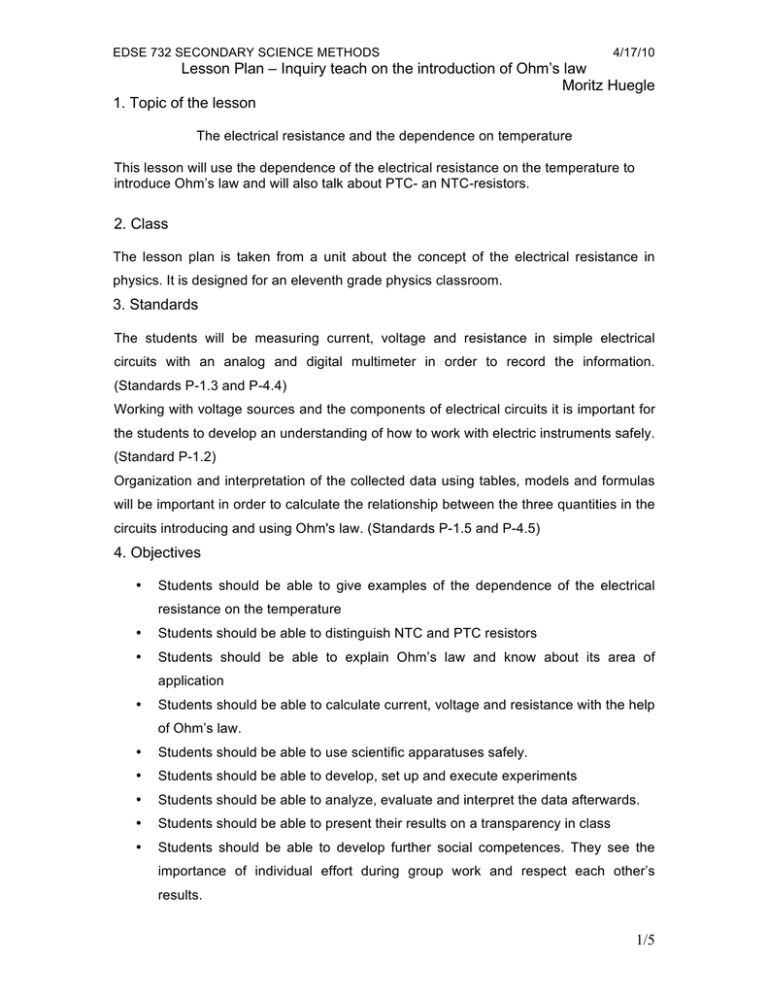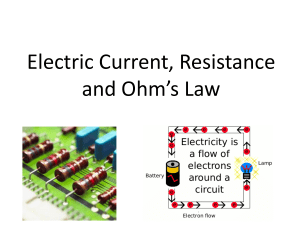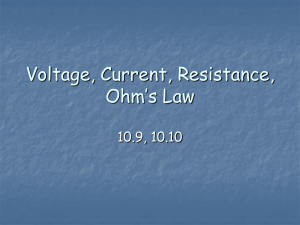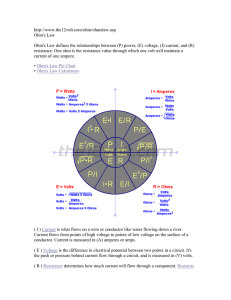Ohm`s Law and the dependence on temperate electrical resistance
advertisement

EDSE 732 SECONDARY SCIENCE METHODS 4/17/10 Lesson Plan – Inquiry teach on the introduction of Ohm’s law Moritz Huegle 1. Topic of the lesson The electrical resistance and the dependence on temperature This lesson will use the dependence of the electrical resistance on the temperature to introduce Ohm’s law and will also talk about PTC- an NTC-resistors. 2. Class The lesson plan is taken from a unit about the concept of the electrical resistance in physics. It is designed for an eleventh grade physics classroom. 3. Standards The students will be measuring current, voltage and resistance in simple electrical circuits with an analog and digital multimeter in order to record the information. (Standards P-1.3 and P-4.4) Working with voltage sources and the components of electrical circuits it is important for the students to develop an understanding of how to work with electric instruments safely. (Standard P-1.2) Organization and interpretation of the collected data using tables, models and formulas will be important in order to calculate the relationship between the three quantities in the circuits introducing and using Ohm's law. (Standards P-1.5 and P-4.5) 4. Objectives • Students should be able to give examples of the dependence of the electrical resistance on the temperature • Students should be able to distinguish NTC and PTC resistors • Students should be able to explain Ohm’s law and know about its area of application • Students should be able to calculate current, voltage and resistance with the help of Ohm’s law. • Students should be able to use scientific apparatuses safely. • Students should be able to develop, set up and execute experiments • Students should be able to analyze, evaluate and interpret the data afterwards. • Students should be able to present their results on a transparency in class • Students should be able to develop further social competences. They see the importance of individual effort during group work and respect each other’s results. 1/5 EDSE 732 SECONDARY SCIENCE METHODS 4/17/10 Lesson Plan – Inquiry teach on the introduction of Ohm’s law Moritz Huegle 5. Context The present unit is about the electrical resistance. Its definition was introduced in the beginning: R:=U/I (U is the voltage, I the current and R is the resistance) The dependence on the material, length and cross section has been established already. The resistance of light bulbs and energy saving lamps has been examined as well. The explanation for the difference between light bulbs and other conductors will be developed throughout this lesson. The electrical resistance depends on the temperature explains the characteristic of the light bulb which is omnipresent in the students’ everyday life. The short discussion about the PTC- and NTC- resistance is just an introduction in the many applications of the different characteristics of materials. Many of those resistors are included in devices of our everyday life. Ohm’s law is one of the most popular and most important laws in electricity. It is the background for any complex electrical circuit and will be needed in the following lessons. 6. Materials Items per group - Voltage source - two mounts and metal conductor, PTC- or NTC resistor - isolated cables - beaker with water - heating plate - a volt- and ampere-meter or a multimeter (analog or digital) - transparencies and pen Items per student - Worksheet about the relationship about Ohm’s law and temperature dependence 2/5 EDSE 732 SECONDARY SCIENCE METHODS 4/17/10 Lesson Plan – Inquiry teach on the introduction of Ohm’s law Moritz Huegle 7. Instructional Sequence Time in Min Section Planned process and activities 5 Quiz Quiz about the electrical resistance 5 Review “We have been talking about different Methods media conductors such as copper and light bulbs and we have analyzed different characteristics. In which way did the light bulb differ from the copper and why?” non-linear characteristic heat (increasing temperature of the wire) Temperature has something to do with electrical resistance 5 10 Introduction “What might happen if we heat conductors?” Stating the How can we examine that and connect it to our problem knowledge about the electrical resistance? Developing Students get together in groups and discuss possible their ideas, what they want to measure, why experiments and how conclusions - Impulse Group work Heating a conductor with a flame ( too hot too quickly, too much danger) 10 Heating a conductor with a water beaker Instructions Decision on one experiment: Teacher for Heating a conductor with a water beaker guided experiments Groups of three or four students discussion The lab procedures will be develop together at Blackboard the board (sketch, instructions, measurements and tables for the data) Each groups gets a pure metal conductor, a NTC-conductor or a PTC-conductor to perform 3/5 EDSE 732 SECONDARY SCIENCE METHODS 4/17/10 Lesson Plan – Inquiry teach on the introduction of Ohm’s law Moritz Huegle the experiment with Safety instructions: - Caution, we are working with water and electricity - Do not turn the power on while anyone is still working on the set-up - lecture Get back to your teacher before you turn the power on Slide or Never touch the water or any wire in the transparency circuit while the power is on - Keep your measuring devices away from the water beaker - Do not heat the water over 50°C 8. Assessment The assessment will start right at the beginning of the lesson with a quiz about the last lessons. After that the lesson will continue with the reasons for the differences between conductors and a light bulb which is a review. The students will then develop an experiment about how to measure the resistance of conductors at different temperatures an perform the experiment. This involves the knowledge about multimeters and the definition of the resistance. During the experiments they will be asked some questions about what they are doing and why. The presentation of the results and conclusions with the following discussion will also assess the student learning’s. And the worksheet will give them the chance to apply their knowledge and review the topic of the lesson. The results are checked at the end of the class. 9. References National Science Education Standards (1996) Retrieved August 23, 2009, from The National Academies Press Web Site: http://www.nap.edu/openbook.php?record_id=4962 South Carolina Curriculum Standards (2005) Retrieved August 23, 2009, from South Carolina Department of Education Web Site: http://ed.sc.gov/agency/Standards-and- Learning/AcademicStandards/old/cso/standards/science/ http://www.sn.schule.de/~ms16l/virtuelle_schule/3de/Kapitel_07_Ohmsches_Gesetz/kap itel_06.htm 4/5 EDSE 732 SECONDARY SCIENCE METHODS 4/17/10 Lesson Plan – Inquiry teach on the introduction of Ohm’s law Moritz Huegle 10. Addendum 10.1 Worksheet: Ohm’s law 1. The resistance of a wire is calculated by measuring the current and voltage at a constant temperature. The current was 0.1A and the voltage was 6V. Calculate the precise value of R. 2. The wire is heated and its resistance is measured to be 90Ω. The voltage was still 6V. How much current is running through the wire? 3. Is the above wire a PTC- or a NTC-resistance? Explain your answer. 4. The current through a wire with the resistance R=100Ω is I=0.05A. What is the value of the voltage 5. Describe in your own words what an ohmic resistance is! 5/5






